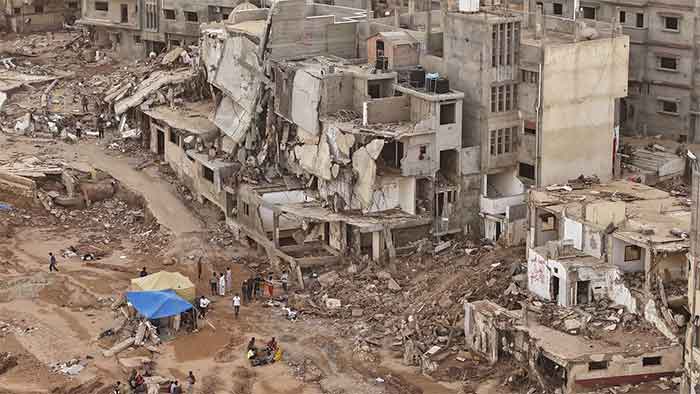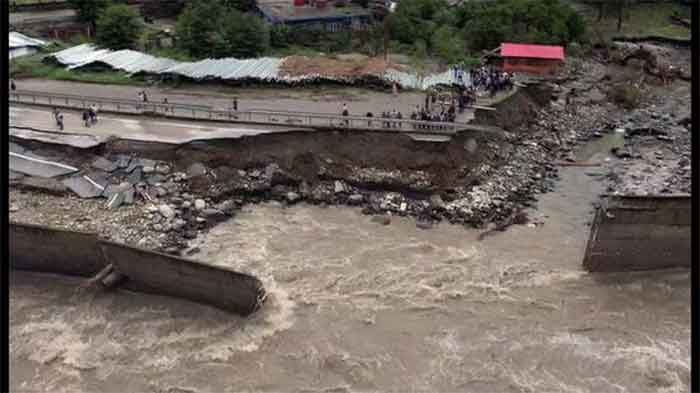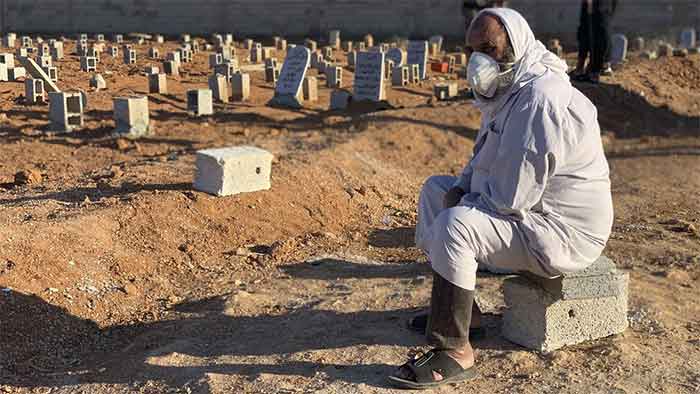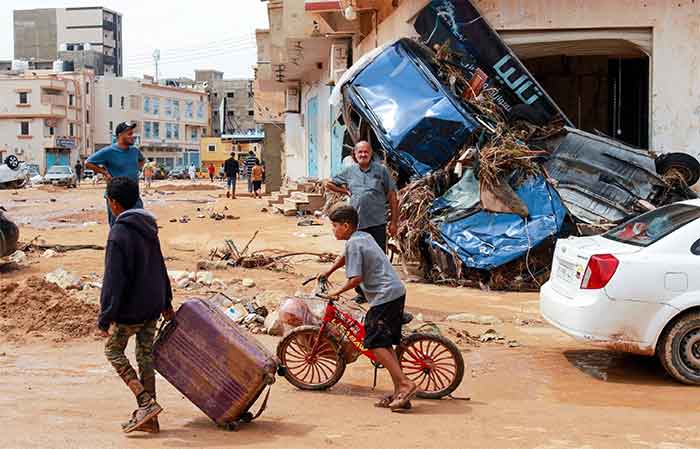
A catastrophic flooding in Libya has taken its toll: At least 10,000 people died. The flood in Libya is just the latest in a string of intense rain events to hammer countries in four continents over the past two weeks. Whole neighborhoods have been swept into the sea by flooding in Libya. The country also experienced bursting of dams. Dead bodies are lying everywhere in the flood-hit region of Libya. Dead bodies are in the sea, in the valleys, under buildings in flood-devastated region.
Media reports including a report by NBC News said:
In the first 11 days of September, eight devastating flooding events have unfolded on four continents. Before Mediterranean storm Daniel sent floodwaters surging through eastern Libya, severe rain inundated parts of central Greece, northwestern Turkey, southern Brazil, central and coastal Spain, southern China, Hong Kong and the southwestern U.S.
Libya’s Flooding, Rising Death Toll
Media reports said:
Catastrophic flooding brought on by a fierce Mediterranean storm that wrecked dams and swept whole neighborhoods into the sea as it lashed Libya on Monday has left at least 5,300 people dead, according to the latest government estimate.
The eastern part of the country was hit hardest by Monday’s storm.
Libya’s state-run news agency LANA reported on Tuesday:
The divided country’s eastern government, based in Tobruk, announced the updated death toll through its interior ministry and pegged the number of people still missing at 10,000. About 6,000 people are still unaccounted for in the coastal city of Derna in northeastern Libya.
The storm caused two dams to collapse, sending a wall of water rushing through a wadi toward Derna, which had already been inundated with rain. Many of the city’s buildings, including entire neighborhoods, were washed away. Derna has a population of about 125,000.
Libya’s civil aviation minister Hichem Abu Chkiouat told Reuters on Tuesday: “Bodies are lying everywhere – in the sea, in the valleys, under the buildings. “I am not exaggerating when I say that 25% of the city has disappeared. Many, many buildings have collapsed.”
Hospitals in Derna have reportedly been knocked out of commission, and their morgues are full. Dead bodies are left on sidewalks outside the morgues, Dr. Anas Barghathy, who is doing volunteer work in Derna, told CNN: “There are no firsthand emergency services. People are working at the moment to collect the rotting bodies.”
Türkiye’s government has dispatched humanitarian aid and 168 search and rescue teams to Benghazi to help in the relief effort. Italy and France are among the European countries that have pledged assistance to Libya.
The disaster came just three days after another North African country, Morocco, was hammered by an earthquake. The death toll there is over 2,900 and counting, making it the country’s deadliest earthquake since at least 1960.
Recovery efforts could be hindered by Libya’s divided governance. The North African country has been split into two competing administrations since 2014, a division that occurred after the assassination of longtime leader Muammar Gaddafi during a NATO-led bombing campaign in 2011. The Government of National Unity (GNU) took power in Tripoli in March 2021 under a UN-backed peace deal. A rival administration, backed by the Libyan parliament, operates from Tobruk.
An NBCNews.com report said:
Seeing that many unrelated extreme weather events around the world in such a short time is unusual, said Andrew Hoell, a research meteorologist at the National Oceanic and Atmospheric Administration’s Physical Sciences Laboratory in the U.S.
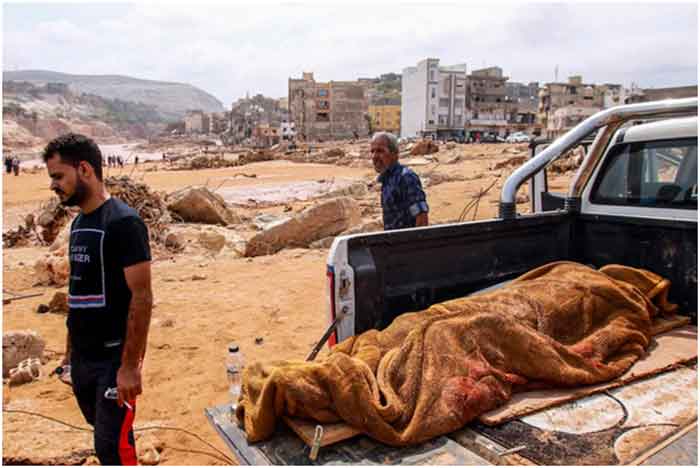
“Sometimes we have a clustering of these events, whether it is in a given country, given hemisphere or globally,” he said. “And it seems like right now, globally, this is prime time for a number of flooding events.”
As with many other forms of extreme weather, scientists say climate change is most likely having an impact on rainfall and flooding, but understanding precisely what that relationship is can be tricky.
In general, studies have shown that global warming is intensifying the planet’s water cycle. Warmer temperatures increase evaporation, which means a warmer atmosphere can hold more moisture. As a result, when storms can unleash more intense precipitation and thus cause severe flooding.

Researchers have observed those changes over time as the world warms. Since 1901, global precipitation has increased at an average rate of 0.04 inches per decade, according to the Environmental Protection Agency.
However, a number of factors can influence flooding events and their severity, and teasing out the fingerprints of climate change when they all interact can be challenging, Hoell said.
“From a 1,000-foot view, it’s definitely true that if you have higher temperatures, you have more water vapor, and therefore you can have more precipitation fall from the sky,” he said. “But when you look at a specific event and the specific set of physical processes relevant to that event, it then becomes difficult to attribute every single process in that causal chain.”
For one thing, the types of extreme weather that caused each of the eight catastrophic flooding events this month had different origins.
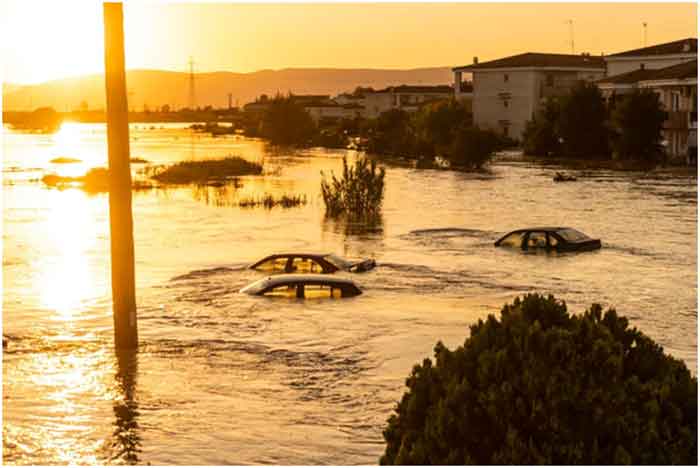
It was a Mediterranean storm named Daniel that dumped heavy rain over central Greece and Libya. Typhoon Haikui and its remnants lashed Hong Kong and southern China with record rain, waterlogging urban and rural areas, destroying roads and causing more than 100 landslides.
Torrential downpours caused flash flooding in central and coastal regions of Spain, northwest Turkey and thousands of miles away in the Brazilian state of Rio Grande do Sul.
And fast-moving thunderstorms over southern Nevada this month caused flash flooding across the region, swamping the Las Vegas Strip and stranding more than 70,000 people at the Burning Man festival in Black Rock Desert.

With certain types of extreme flooding events, such as those associated with Mediterranean cyclones like Daniel, there simply is not enough data to observe shifts over time.
“We really do not have a long enough sample or record to be able to detect a change, because they’re not really that common of an occurrence,” Hoell said.
In other cases, local factors, such as how wet or dry the ground is or an area’s basic topography, can have enormous influences on how floods develop — and their consequences.
Beyond loss of life and property, floods increase the risks of exposing people to waterborne pathogens, which have important implications for outbreaks of deadly disease.
Hoell said the number of devastating floods this month is distressing, but he said he’s especially concerned about the situation unfolding in Libya.
“If you look at the damage and the amount of people who have lost their lives,” he said, “it just blows your mind.”
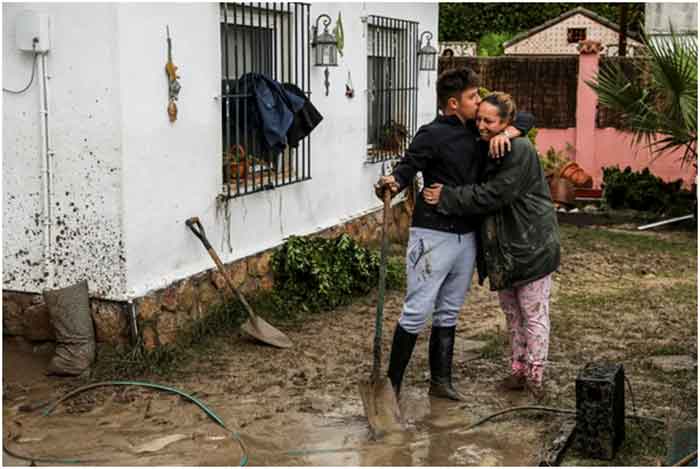

Greece’s daily rainfall record was broken with 754 mm of rain in the village of Zagora – more than double the UK’s equivalent record. Credit: National Observatory of Athens/meteo.gr, CC BY-SA
Record Rainfall In Greece
An article in The Conversation (Greece’s record rainfall and flash floods: Across the Mediterranean, the weather is becoming more dangerous, Sept. 11, 2023) by Ioanna Stamataki said:
Recent images of the devastating flash floods caused by Storm Daniel in Greece hit close to home literally and figuratively. As a Greek who has completed a Ph.D. and worked for the past eight years on flash floods, the scenes unfolding across my homeland are painfully real: a stark reminder of the broader environmental challenges we face both on a local and a global scale.
These unprecedented flash floods were triggered by rainfall from the arrival of Storm Daniel on Monday September 4 which also affected Turkey and Bulgaria. The following day, in the village of Zagora, a record-breaking 754mm of rain fell in just 18 hours, leaving parts of the region of Thessaly in crisis and unable to respond.
To put this in perspective, London gets about 585mm of rain over the course of a year while Thessaly gets 495mm, meaning that on Tuesday, about 1.5 years’ worth of rain fell in 18 hours. Imagine the most torrential rain you have ever experienced, perhaps a cloudburst lasting 20 minutes or so. Now imagine it raining that hard but without pause for an entire day.
Flash flooding is short in duration but extremely intense, and typically happens within six hours of heavy rainfall. Unlike regular floods, which develop more slowly and can be predicted in advance, flash floods catch people off guard due to their rapid onset and are rarely recorded in the field.
Catastrophic Effects
The article said:
Across the three affected countries the floods have killed at least 18 people, with many others seeking refuge on their rooftops. There are ongoing power and water outages, infrastructure has been damaged, houses and even entire villages have been completely submerged.
I asked Andrew Barnes, an academic at the University of Bath with expertise in using AI to analyze extreme events why this event was so exceptional. He told me that throughout Tuesday, a strong low-pressure center formed across the south of Greece creating a large rotating weather system known as a cyclone.
This cyclone carried large rain clouds from both the Mediterranean and Aegean Sea between Greece and Turkey. But it did not dissipate, and instead its low-pressure center moved southwest and settled just south of Italy, with its bands of rain clouds also moving south and covering most of mainland Greece.
Trending Across The Region
The article said:
It is crucial to emphasize that flash floods are not confined to Greece alone. They are in fact part of a broader pattern of extreme weather that has become more intense and frequent across the Mediterranean region.
Researchers who looked at 150 years of flood data in the Mediterranean found that most were flash floods, with their highest occurrence during the summer and autumn months. The region is particularly susceptible to these floods due to the combined effects of climate change and urbanization. The latter has increased urban development in flood-prone areas and increased impervious surfaces (like roads and pavements), preventing the natural absorption of water into the ground.

The Intergovernmental Panel on Climate Change’s chapter on the Mediterranean region issued a warning that extreme rainfall events are going to occur more often and be even more intense, elevating the risk of flash floods. This warning, in combination with records of flash floods in 2023 in Spain, Italy, Turkey, Bulgaria, France and Greece, underscores the urgent need for proactive measures to address these climate-related challenges.
Research Is Advancing
It added:
Flash floods might be rare, but they are severe enough to be a matter of significant concern. Fortunately, research has advanced considerably in recent years. We’re now better able to forecast when flash floods might happen, which areas might be susceptible, and to assess their impact in real-time.
My colleagues and I are working on a project that combines historical documentary sources and modern hydraulic modeling. This way we can shed light on past floods and better understand the risks they pose, helping us design effective mitigation strategies for the future. Practically, in the case of a flash flood some basic but very important actions can be found on the poster below.
A complete eradication of flooding is neither technically feasible nor economically affordable. Instead on a larger scale it is key to start identifying flash-flood prone areas especially in catchments with historical flash floods. We should then focus on advocating for climate action and resilience measures, which can be anything from “hard” defenses like new flood walls, through to policies and better public awareness of the risks. Only this will offer hope of a safer and more resilient future.
Aid And Politics
A report by Los Angeles Times (What’s delaying lifesaving aid after Morocco and Libya natural disasters? Politics, Sept. 13, 2023) said:
The scale of destruction in North Africa is staggering: In Morocco, a massive earthquake has left more than 2,900 dead and thousands more injured or homeless. In Libya, more than 5,300 are dead and 10,000 missing after a storm unleashed floodwaters and burst dams.
Devastated communities have waited days for help, often digging out and burying their dead with little to no assistance from their governments. Some of the delay can be blamed on destroyed infrastructure. But the bigger roadblock is politics.
Though other governments and aid groups swiftly offered assistance — including rescue and relief teams — help has been snarled by rivalries.
If there were a time when political differences could be set aside, the aftermath of a natural disaster might seem to qualify. But the responses in both Morocco and Libya — one a stable nation, the other torn by war and ruled by rival governments — show the difficulty of separating humanitarian aid from political considerations.
Outside Morocco, there’s bewilderment: Despite dozens of international teams ready to mobilize after Friday’s magnitude 6.8 earthquake, the government in Rabat has officially accepted assistance from only four nations it deems “friendly” — Qatar, the United Arab Emirates, Spain and Britain — and that acceptance came two days after the earthquake.
The report said:
In Morocco, where the 72-hour “golden period” for saving lives has already passed, thousands are complaining that authorities have all but abandoned them, furious at what they say is the government’s lackadaisical response.
The Interior Ministry on Sunday sought to justify its reticence in welcoming aid, saying a “lack of coordination would lead to counterproductive results.”
But observers point out that geopolitics appears to be its real concern.
Algeria, which two years ago severed ties with Morocco over sovereignty issues in Western Sahara, opened its airspace to facilitate aid flights’ access and scrambled 80 rescue workers to help. After two days of silence, Morocco said Tuesday that it did not need its neighbor’s assistance, according to the Algerian Foreign Ministry.
That attitude reflects the views of King Mohammed VI, who “made it clear that Western Sahara was the lens through which Morocco would view all foreign engagement,” said Geoff Porter, president of North Africa Risk Consulting and an expert on the Maghreb region.
“Thus, aid offers are still viewed as tools of foreign policy,” Porter said. “This means that aid and relief cannot be accepted from countries that do not unequivocally recognize Moroccan sovereignty over Western Sahara.”
That might explain why Germany had to stand down a 50-person team from its Technical Relief Agency that had assembled at Cologne airport to fly to Morocco.
“It is incomprehensible that Rabat has so far forgone German help,” said Carl-Julius Cronenberg, who chairs the German Parliament’s group on the Maghreb, in a statement to the German newspaper Tageespiegel.

“The current situation should not be about misunderstood national pride.”
France, which colonized Morocco until 1956 — and has seen relations chill after disagreements over visa and immigration issues as well as France’s outreach to Algeria — was also rebuffed, with a team from the French aid group Rescuers Without Borders unable to enter the country.
“Unfortunately, we still do not have the go-ahead from the Moroccan government,” Arnaud Fraisse, the group’s founder, said Sunday in a statement to broadcaster France Inter.
French Foreign Minister Catherine Colonna downplayed any rancor between the two countries, saying in an interview with BFM television on Monday that it was little more than a “misplaced controversy.”
“We are ready to help Morocco. It is a sovereign Moroccan decision, and it is up to them to decide,” she said, adding that Paris has prepared a $5.4-million fund for nongovernmental organizations operating in Morocco.
In Morocco, the response, troubled as it is, is at least being overseen by a stable government.
Libya has seen more than a decade of internecine conflict that has left the country with two rival governments, one in the capital, Tripoli, and another controlling the country’s east, based out of the city of Benghazi.
It is in the east where the coastal city of Derna was mostly destroyed after relentless rain burst nearby dams, unleashing floods that washed away homes, cars, people and whole neighborhoods. Authorities say that at least a quarter of the city no longer exists.
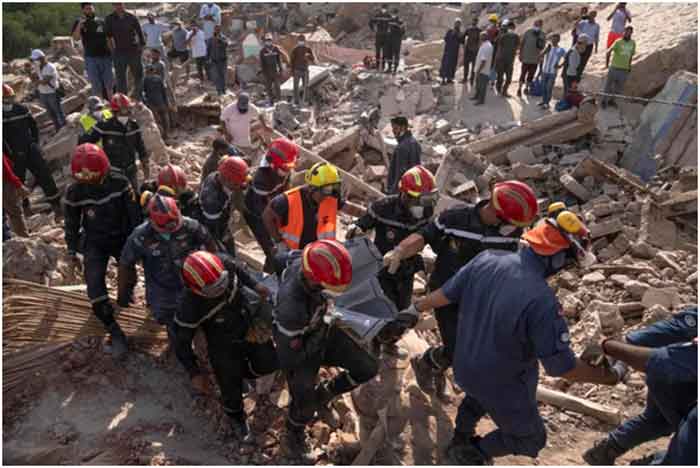
Officials from the eastern-based administration rushed to declare a response. Khalifa Haftar, the military leader who supports the eastern-based administration, urged Libya’s central bank to provide support.
“We have directed the government to form a specialized committee to assess the damage, instantly begin the reconstruction of roads to facilitate transportation, restore the electricity and take all immediate and needed measures,” Haftar said in a televised statement.
Meanwhile, Abdul Hamid Dbeibah, the prime minister of the Tripoli government, also weighed in, saying that the country was assessing aid offers from the international community.
“There were multiple offers of help and we will only accept aid that is necessary,” he said.
Videos on social media showed helicopters from the eastern army helping recover corpses from waterlogged boulevards. Volunteers with the International Federation of Red Cross and Red Crescent Societies have mounted rescues of entire families from vehicles about to be swept away by the torrent. Three volunteers died helping stranded families, the aid group said Tuesday.
Hisham Abu Shkeiwat, a minister with the eastern government, said the massive numbers of corpses strewn across the streets and on the coast makes the city all but uninhabitable.
Local activists have been compiling lists of the dead, posting hastily scribbled notices on Facebook and other platforms. And in a sign of solidarity, the Tripoli government has dispatched aid convoys and planes carrying first responders and body bags.
But eastern administration officials denied there had been any direct contact with the Tripoli government. “If there has been any contact, I have not heard of it,” Ahmed Mismari, spokesperson for the self-styled Libyan National Army, the force that controls the eastern region, said in a TV interview, adding that now was not the time for political jockeying.
Meanwhile, some international aid has begun to arrive, including 168 rescuers, two search-and-rescue vehicles, and two rescue boats that arrived from Turkey, which will also send tents, blankets, food and other supplies. Italy is also sending civil defense teams.
Egypt scrambled a military delegation along with medical supplies. The Emirates, Qatar, Iran and Algeria said they have sent aid.
The U.S. State Department, meanwhile, said in a statement Monday that it was coordinating with “U.N. partners and Libyan authorities on how we can assist the ongoing relief efforts.”
In his interview, Mismari said the eastern government was dealing directly with Egypt, the Emirates and Turkey. Turkey has long supported the Tripoli government, providing it with military assistance that saved it from Haftar’s assault in 2019. But since the fighting ended, Ankara has made inroads with the east.
In such a divided nation, coordination problems will inevitably arise, said Tim Eaton, Libya researcher at the Chatham House think tank in London.
“There are 140 state institutions divided between the east and west governments, so the logistics of a response are awful,” he said.
What that means, said Anas Gomati, director of the Sadeq Institute, a Tripoli think tank, is that “we do not know what is required.”
Visas issued by the Tripoli government do not necessarily apply to the east; aid groups hoping to deploy cannot be sure they have reached the right point of contact; and since municipal elections did not take place this year because of tensions between the two governments, local officials would have little in the way of data, he added.
That the storm’s ferocity hits its apex in Derna adds another complication: Residents there have long had an unhappy relationship with both governments, especially the one under Haftar, who led a multi-year siege and then a destructive urban campaign to root out Islamist fighters that ended in 2019.
“The population of Derna is not treated the same way as in other municipalities, since they are often seen as trouble,” said Jalel Harchaoui, a Libya analyst at the Royal United Services Institute, a London-based security think tank. “And with that comes this kind of condescension and antipathy.”
That mentality had already cemented a history of neglect when it came to Derna, said Gomati, who pointed out that competition between the two governments and their disdain of Derna meant infrastructure projects, including the two failed dams, had been largely neglected.
Whereas Morocco’s disaster came without warning, Libyan authorities had plenty of time to take preventive measures as they watched Storm Daniel bulldoze its way through Greece, Gomati added.
“They had days before the storm came, hours to watch the banks of the dams reach to a level that was critical, and they did not sound the alarm, they did not prepare an evacuation plan.”
Though he acknowledged the scale of the disaster was unprecedented for Libya, Gomati nevertheless blamed authorities for insisting residents stay in place.
“The fact of the matter is that Libyans would have preferred Derna city to be underwater, rather than the city plus its inhabitants,” he said.
“What led up to this were lethal errors, which will also sabotage the aid effort on the ground, because the people in charge are not responsible enough.”
The Los Angeles Times report said:
Another issue facing the Libya response is a matter of attention.
“Everyone is familiar with and everyone adores Morocco, less as a country than a locale. Libya, and especially Derna, is toxic. It is untouchable,” said Porter, the expert on the Maghreb region, who noted that people associate Derna with Islamic State militants after an earlier occupation.
“Besides, Derna is inaccessible. Journalists have not been able to get there for nearly a decade. It is cut off, unknown and unknowable.”

